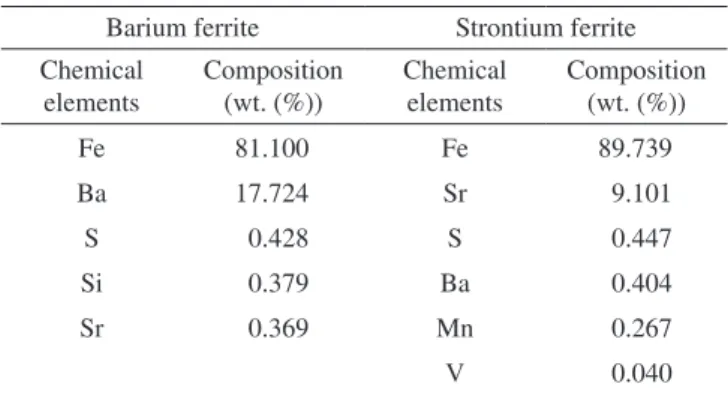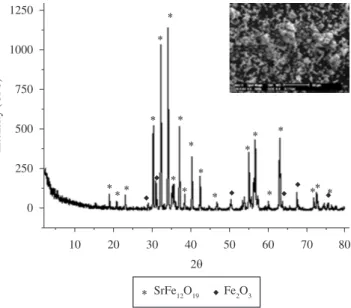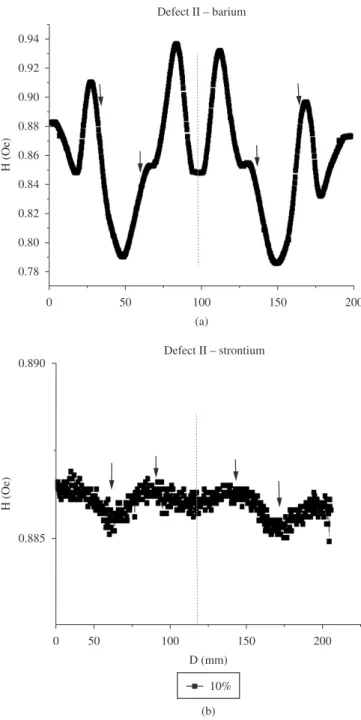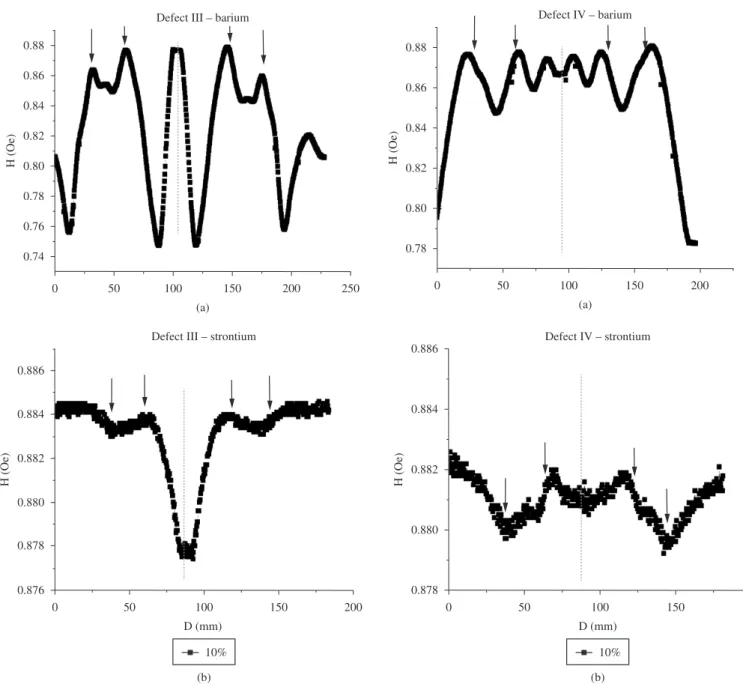DO:
D 10.1590/S1516-14392011005000071
*e-mail: anapfulco@yahoo.com.br
Addition of Magnetic Markers for Non-destructive Evaluation
of Polymer Composites
Ana Paula Pereira Fulcoa*, José Daniel Diniz Meloa, Carlos Alberto Paskocimasa,
Suzana Nóbrega de Medeirosb, Fernando Luis de Araujo Machadoc, Alexandre Ricalde Rodriguesc
a
Departamento de Engenharia de Materiais, Universidade Federal do Rio Grande do Norte – UFRN,
Natal, RN, Brazil
b
Departamento de Física, Universidade Federal do Rio Grande do Norte – UFRN,
Natal, RN, Brazil
c
Departamento de Física, Universidade Federal Pernambuco – UFPE,
Recife, PE, Brazil
Received: March 24, 2011; Revised: August 2, 2011
Polymer composite pipes are an appealing option as a substitute for conventional steel pipes, particularly due to their inherent corrosion resistance. However, the composite pipes currently used do not allow non-destructive evaluation (NDE) using instrumented devices which operate with magnetic sensors. The present work aims at the development of polymer composites with the addition magnetic markers to allow the application
non-destructive evaluation techniques which use magnetic sensors. Glass-polyester composite lat, circular plates were
fabricated with the addition of ferrite particles (barium ferrite and strontium ferrite) and four types of notches
were introduced on the plates’ surfaces. The inluence of these notches on the measured magnetic properties of each material was measured. X-ray diffraction (XRD), X-ray luorescence (XRF) and Brunauer, Emmett, and Teller (BET) nitrogen adsorption were used for the characterization of the ferrite particles. Particle dispersion in the polymer matrix was analyzed by scanning electron microscopy (SEM). According to the results, a particular variation in magnetic ield was detected over the region surrounding each type of notch. The results suggest that
the proposed technique has great potential for damage detection in polymer composites using magnetic sensors and thus constitute a valuable contribution which may ultimately lead to the development of non-destructive evaluation techniques for assessing the structural integrity polymer composite pipes.
Keywords: composite materials, magnetic markers, non-destructive evaluation
1. Introduction
Steel pipelines are commonly used in the petroleum industry for
the transport of oil and gas. However, corrosion leads to reduced time life of these components and the need for frequent inspection, repairs or replacement. Polymer matrix composite pipes, alternatively, offer advantages over steel tubes for this application due to the corrosion
resistance inherent to this type of material and other beneits such
as weight reduction1-4. Many types of resins and iber reinforcement materials are currently used in composites for oilield applications.
While glass is the typical reinforcement material, polyester, vinyl ester, and epoxy are the most prevalent resins1. Nonetheless, the
conventional polymer composite pipes currently used do not allow non-destructive evaluation (NDE) using instrumented pigs which operate with magnetic sensors.
Approaches to detect damage and internal defects in polymer composite materials are of great interest, both for quality control during the production stages, as well as for in-service inspections and during maintenance operations. The use of non-destructive evaluation (NDE) techniques is necessary to access structural integrity without causing damage to the materials. NDE techniques currently used to examine composite materials include ultrasound, thermography, shearography and X-ray computed tomography (XR-CT)5-7.
Shearography has been used for nondestructive evaluation of
composites including delamination detection with various types of excitation loads including thermal, vacuum and internal pressure6.
Thermography has also been proven capable of evaluating internal defects in composites. Although the technique is highly sensitive to detect delamination, there are limitations for high-thickness measurements6. X-ray CT provides very high resolution images
and complete 3D reconstruction of the part evaluated and can detect
defects such as voids, cracks, inclusions, dry ibers and delaminations.
On this case, the parts to be tested can be thick due to the relatively low X-ray attenuation of the polymer composites. Ultrasonic techniques have been extensively used for inspection of metallic
parts for law detection/evaluation, dimensional measurements, material characterization7. On composites, ultrasonic inspection is
able to detect delaminations and provide in-depth information, even relatively thick parts.
Magnetic lux leakage (MFL) is the most used technique for the
inspection of steel pipelines in the petroleum industry8. However, this
technique is not suitable for polymer composites since the material
cannot be magnetized. Thus, the addition of magnetic particles to
changes in magnetic ield. When there is a defect in the material to be inspected, there are distortions in the magnetic ield detected by
transducers and converted into electronic signals9.
Ferrites are magnetic materials with a special characteristic: they
have spontaneous magnetic induction in the absence of an external
magnetic ield. Ferrites are a well established family of magnetic
materials, which are inexpensive and chemically stable. Thus, this large class of ceramic materials10 has a wide range of technological
applications.
The objective of this work was to study the variations in magnetic
ield around notches in polymer composite plates with the addition of
magnetic markers. Two types of ferrite (barium and strontium) were used as magnetic markers and four types of notches were introduced on the surface of the plates. The measurements indicated that each
notch produced a characteristic signature in the magnetic ield.
2. Experimental
Composite circular plates were fabricated by hand lay-up
with a diameter of 500 mm for the magnetic characterization. The
materials used were: balanced plain weave fabric E-glass (450 g.m–2),
orthophthalic polyester, barium ferrite particles (for type 1 disk) and
strontium ferrite particles (for type 2 disk). Both ferrites were acquired from FERMAG - Ferritas Magnéticas Ltda - BRAZIL. Polyester
resin was mixed with the ferrite particles using a mix ratio in parts by weight (pbw) of 90:10 (resin: particles). A mechanical shaker with speed of 1750 rpm was used to disperse the ferrite particles in the polymer matrix for a period of 20 seconds. Then, the layers of glass fabric impregnated with the liquid mixture (polyester resin combined with ferrite particles) were laid up to form a laminated composite
with ifteen layers. Rollers were used on each layer to help remove
air bubbles and promote compaction. After the cure of the polymer resin was complete, the plates were cut into a circular shape using a
diamond abrasive saw. Four types of notches were then introduced onto the composite disks using a drill. Figure 1 shows the composite
disk with notches.
Before the fabrication of the disks, the ferrites were analyzed on a Shimadzu EDX-820 Energy Dispersive X-ray Fluorescence Spectrometer for the determination of the chemical composition.
X-ray diffraction patterns of samples of ferrite particles were
determined on a X-ray diffractometer XRD-6000 Shimadzu, with
copper tube (λ = 1.5418 Å). The scan was perfomed over the range
20-80° (2θ). The surface area, pore diameter and average pore volume of the ferrites were obtained by determining the adsorption isotherms of N2 (g) at 77 K in a Micromeritics ASAP 2010 using
the BET method (Brunauer, Emmet and Teller). These parameters
are important to determine the morphology of the particles and the existence of agglomerates.
The particle dispersion in the composite was observed using a
scanning electron microscope (SEM) Shimadzu SSX-550, where the images were generated using backscattered electron (BSE) imaging. SEM has been used by other authors to observe particle dispersion and
the presence of agglomerates in polymeric composites with micron-
and nano-sized particles11-13. Variations in the magnetic ield on the
composite disks with the addition of magnetic particles (barium and strontium ferrites) were measured using a custom-made apparatus
(Figure 2). The disks were mounted on a shaft of a stepper motor
in which it was possible to control the speed and direction of spin.
A magnet was kept ixed near the disk and a Hall effect sensor, also ixed and connected with a FW Bell gaussmeter capable of measuring three perpendicular components of the magnetic ield, was kept close to the magnet. The magnetic ield produced by magnetization of the samples and the distortion of the magnetic ield produced by the
Figure 1. Polymer matrix composite disk with notches.
Figure 2. Equipment for measuring the magnetic ield.
Table 1. Chemical composition of barium ferrite and strontium ferrite obtained
by X-ray luorescence.
Barium ferrite Strontium ferrite
Chemical elements
Composition (wt. (%))
Chemical elements
Composition (wt. (%))
Fe 81.100 Fe 89.739
Ba 17.724 Sr 9.101
S 0.428 S 0.447
Si 0.379 Ba 0.404
Sr 0.369 Mn 0.267
Figure 3. X-ray diffractogram and SEM micrograph of barium ferrite particles. Figure 4. X-ray diffractogram and SEM micrograph of strontium ferrite
particles.
AccV 20.0kV
Probe 4.0
Mag ×400
WD 23
Det SBSE
AccV 20.0kV
Probe 3.5
Mag ×2700
WD 23
Det SBSE
Figure 5. Micrographs of the polymer composite with barium ferrite.
Figure 7. Magnetic ield (Oe) vs. distance (mm) for the notch I. Figure 8. Magnetic ield (Oe) vs. distance (mm) for the notch II.
notches were detected by the sensor. Data were acquired through a
computer using a GPIB interface controlled by a program in Labview.
To verify the repeatability of the results, the direction of rotation
of the disks was reversed over the limits of each notch. Symmetrical
curves about the point of return would indicate a clear contribution of
the notch for the deformation of magnetic ield lines over the region.
Each notch region was measured three times, in both directions.
3. Results and Discussion
The results of X-Ray Fluorescence obtained for the two types of
ferrites are presented in Table 1.
The results presented in Table 1 indicate that the relations in percentage by weight for barium ferrite are very close to the values of stoichiometric barium hexaferrite. Thus, the presence of residual iron oxide can be attributed to stoichiometric deviations generated during the manufacturing process. On other hand, the results for the
ferrite strontium show a strontium excess superior of 3% by weight,
which is associated with the presence of residual iron oxide identiied
by XRD, suggesting that the production process is more subject to variations in of stoichiometry. The level of impurities found for the two systems arises from the use of industrial raw materials and ores
containing S, Si, Mn and V.
Figures 3 and 4 present the X-ray diffractograms for barium
ferrite and strontium ferrite, respectively. The results show that the
Figure 9. Magnetic ield (Oe) vs. distance (mm) for the notch III. Figure 10. Magnetic ield (Oe) vs. distance (mm) for the notch IV.
magnetic response from the magnetic material and, as long as the
composition remains unmodiied, the presence of small amounts of
residual iron oxide should not result in any negative effect to the properties of the product.
BET measured speciic surface area for the barium ferrite was
1.3928 m2.g–1, while for the strontium ferrite the measured speciic
surface area was 1.0283 m2.g–1. These low surface areas of the two
materials are consistent with the microscopy results which indicated the presence of agglomerates.
Figure 5 corresponds to the SEM image of the microstructure
of polymer composites containing barium ferrite. The backscattered electron images suggest the presence of agglomerates of ferrite in
the polymer matrix distributed between the layers of glass iber
reinforcement. These agglomerates were observed throughout the
entire composite sample analyzed. The presence of agglomerates is
undesirable, since they are expected to affect the magnetic response of the material. On practical terms these agglomerates may thwart the
detection of micron-sized defects or the differentiation of the contour in some types of defects in this size domain. However, the magnetic
non-destructive analysis was used in this work to detect defects
larger than several millimeters in size. In addition, the distribution of
particles can be improved by controlling the dispersion in the polymer by properly mixing the composites under ultrasound or by using a mechanical shaker as done in the present work.
Figure 6 shows the microstructure of the polymer composite
containing strontium ferrite. This sample also revealed the presence of agglomerates, with the same negative implications as previously
discussed. In both systems, it was found that the micron size ferrite particles formed agglomerates with sizes exceeding 10 microns.
Figures 7-10 present the changes in magnetic ield (Oe) measured
perpendicular to the plane of the samples versus distance (mm) for the
notches I, II, III and IV (Figure 1), respectively. Each igure shows the
results for the composites with the addition of barium and strontium
coincide with the dimensions determined in disks. Notches O, OO, OOO and OV have lengths respectively of 16, 30, 28 and 32 mm, thereby
conirming that the signal obtained is characteristic of each notch.
The repeatability of the measured signals was also assessed using measurements in clockwise and counterclockwise directions, which in this case the same shape of the curve that represents the measured
magnetic ield versus distance was veriied. The dashed line in the igures indicates the location where the rotation was reversed. Each
notch region was measured three times, in both directions, and no difference was observed in the measured data.
The results presented in Figures 7-10 clearly indicate the variation in magnetic ield produced by presence of notches. It is observed that the signals measured in disks with barium ferrite are better deined,
with a clear indication of the beginning and end of the notch, and a particular shape for each type of notch. The difference between the magnetic signals measured in composites with strontium and barium ferrites is believed to be related to the difference in atomic weight of
Sr and Ba – atomic weight of Sr is 64% of the atomic weight of Ba -
considering the fact that both composite materials were prepared using the same parts by weight. Thus, the particles in the material with the strontium ferrite are closer to each other than in the barium one which,
in turn, it is more inluenced by the demagnetizing dipolar interaction
among those particles. A smaller separation among particles can also
favor the formation of more agglomerates as indicated by the BET
data. These effects in addition to the intrinsic magnetic response of each system should be further evaluated in future work.
4. Conclusions
In this work, circular glass/polyester composite plates with the
addition of magnetic particles of barium or strontium ferrites (10 wt.
(%)) were produced. Four notches were introduced on the composite plates and the variations in magnetic ield produced by the presence of notches were measured. Variations in magnetic ield were detected
in regions surrounding the notches. Moreover, each type of notch
produced a particular change in magnetic ield measured along the circumferential path which includes the notches. SEM images
indicated the presence of agglomerates of magnetic particles in some
regions of the plates, which are known to affect the magnetic ield even
in the absence of notches. Nevertheless, signs of change in magnetic
ield due to notches were reproducible and characteristic for each type
of notch. Composites with the addition of barium ferrite presented curves with less dispersion and better correlation with the geometry of notches. The results indicate that the proposed technique has great potential for damage detection in polymer matrix composites.
Acknowledgements
ANP – National Agency of Petroleum, Natural Gas and Biofuels
is acknowledged for the fellowship support of the author Ana Paula
Pereira Fulco during the development of this work, as part of PRH-30.
The authors are also grateful to Evans P. C. Ferreira of Tecniplas Nordeste Plásticos Reforçados Ltda – Brazil for his valuable support during the fabrication of the composite plates. FERMAG - Ferritas Magnéticas Ltda - BRAZIL is acknowledged for the generous
donation of the ferrites used in this investigation. Work partially
supported by CNPq, FACEPE and FINEP.
References
1. Hossain ME. The current and future trends of composite materials: an experimental study. Journal of Composite Materials. 2011.
2. Yang C. Design and analysis of composite pipe joints under tensile loading. Journal of Composite Materials. 2000; 34:332-349.
3. Perreux D and Suri C. A study of the coupling between the phenomena of water absorption and damage in glass/epoxy composite pipes. Composites Science and Technology. 1997; 57:1403-1413. http://dx.doi.org/10.1016/ S0266-3538(97)00076-6
4. Frost SR and Cervenka A. Glass ibre-reinforced epoxy matrix
ilament-wound pipes for use in the oil industry. Composites Manufacturing. 1994;
5(2):73-81. http://dx.doi.org/10.1016/0956-7143(94)90058-2
5. Huang YD, Froyen L and Wevers M. Quality control and non-destructive
test in metal matrix composites. Journal of Nondestructive Evaluation. 2001; 20(3):113-32. http://dx.doi.org/10.1023/A:1013503005743 6. Amenabar I, Mendikute A, López-Arraiza A, Lizaranzu M and
Aurrekoetxea J. Comparison and analysis of non-destructive testing techniques suitable for delamination inspection in wind turbine blades.
Composites: Part B. 2011; 42:1298-1305. http://dx.doi.org/10.1016/j.
compositesb.2011.01.025
7. Bayraktar E, Antolovich SD and Bathias C. New developments in
non-destructive controls of the composite materials and applications in manufacturing engineering. Journal of Materials Processing Technology.
2008; 206:30-44. http://dx.doi.org/10.1016/j.jmatprotec.2007.12.001 8. Gloria NBS, Areiza MCL, Miranda IVJ. and Rebello JMA. Development
of a magnetic sensor for detection and sizing of internal pipeline corrosion
defects. NDT & E International. 2009; 42(8):669-677. http://dx.doi.
org/10.1016/j.ndteint.2009.06.009
9. Mix PE. Introduction to Nondestructive Testing. Austin, Texas: John
Willey & Sons Inc.; 2005.
10. Sugimoto M. The Past, Present, and Future of Ferrites. Journal of the American Ceramic Society. 1999; 82(2):269–80.
11. Cho J, Joshia MS and Sun CT. Effect of inclusion size on mechanical
properties of polymeric composites with micro and nano particles.
Composites Science and Technology. 2006; 66(13):1941-1952.
http://dx.doi.org/10.1016/j.compscitech.2005.12.028
12. Singh RP, Zhang M and Chan D. Toughening of a brittle thermosetting polymer: Effects of reinforcement particle size and volume fraction. Journal of Materials Science. 2002; 37:781-788. http://dx.doi. org/10.1023/A:1013844015493
13. Melo JDD, Almeida CRR, Paskocimas CA, Mendonça RM and Medeiros



